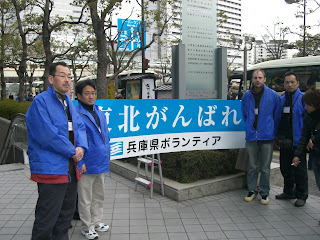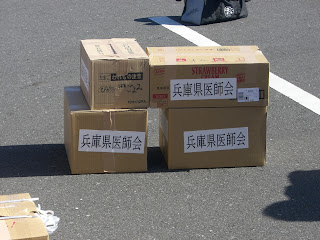On Friday 20th March 2011, we travelled up to Miyagi prefecture (the area that was probably the worst affected by the tsunami) with a group organised by the `Hyogo Voluntary Plaza`, which is a group of specialists from many professions, including doctors, bone setters, earthquake researchers, builders, and of course acupuncturists, all based around Kobe andthe Hyogo area.
We left Kobe at around 5pm, and arrived at the camp in Miyagi at 10am. Most of the volunteers had to return back to Kobe at 5pm the next day (leaving Miyagi), hence there was not much time to offer treatment, and hence the need for us to try to raise donations so we can actually spend a more prolonged amount of time offering assistance to survivors of the tsunami.
The Hyogo Shinkyu (Acupuncture) Association (plus me and Hiroshi, who were honorary members for a couple of days). The sign reads `Tohoku ganbare`, which roughly translated means `Good luck/you can do it/we wish you the best Tohoku!`
Hiroshi Yamamoto, picking up instructions for the trip (map/group assignments etc.)
Getting ready to leave Kobe
Governor of Hyogo prefecture Toshizou Ido giving words of encouragement (I think), to volunteers
Earthquake damage at the service area
Coffee, coffee or coffee?
Our Bus
Hiroshi`s breakfast (and lunch)
Sign reads: Business is closed due to earthquake
Sign reads: Suspension of water supply from 15th March due to earthquake
Rolling moxa cones (chi netsu kyu) on the bus (potentially going to be a lot of people who have been in the cold for days, so the idea was that we might be able to use moxa - a herb effectively used in acupuncture often for its warming ability)
Mountains near Sendai
Queues for petrol - A lot of petrol stations in Sendai and the surrounding areas were closed because they were damaged in the earthquake, or lacked the power to run pumps, or had run out of fuel
.
Arriving at first camp, and getting instructions
A car that has returned from the Tsunami struck area
Nurses from Kobe - both were in Kobe at the time on the Hanshin earthquake in 1995. The lady on the right told me how the water supply in the hospital that she worked in was cut for 3 weeks. Most people from Kobe that I have spoken to, and were involved in the Hanshin earthquake, are extremely keen to help the people of Tohoku, and feel a deep empathy for the victims of the tsunami
Entrance to first camp, where the 2 other/actual members of the Hyogo Shinkyu Association were deployed. The building that you can see is housing a swimming pool, which has been filled with drinking water and is being used as a water storage tank to provide water for the 200 people that have been relocated to this evacuation camp not far from Sendai, in Miyagi prefecture.
Gathering blankets to give to the survivors in the camp
Me after just arriving at the first camp, where the other two members of the acupuncture team were sent. We were dispatched to another camp about 5 minutes drive away.
Hiroshi helping to offload supplies from one of the coaches. Supplies seemed to consist mostly of drinks, some food and blankets.
Medical supplies (reads Hyogo Medical Association)
Teamwork: Getting the supplies inside to a dry storage area



























































